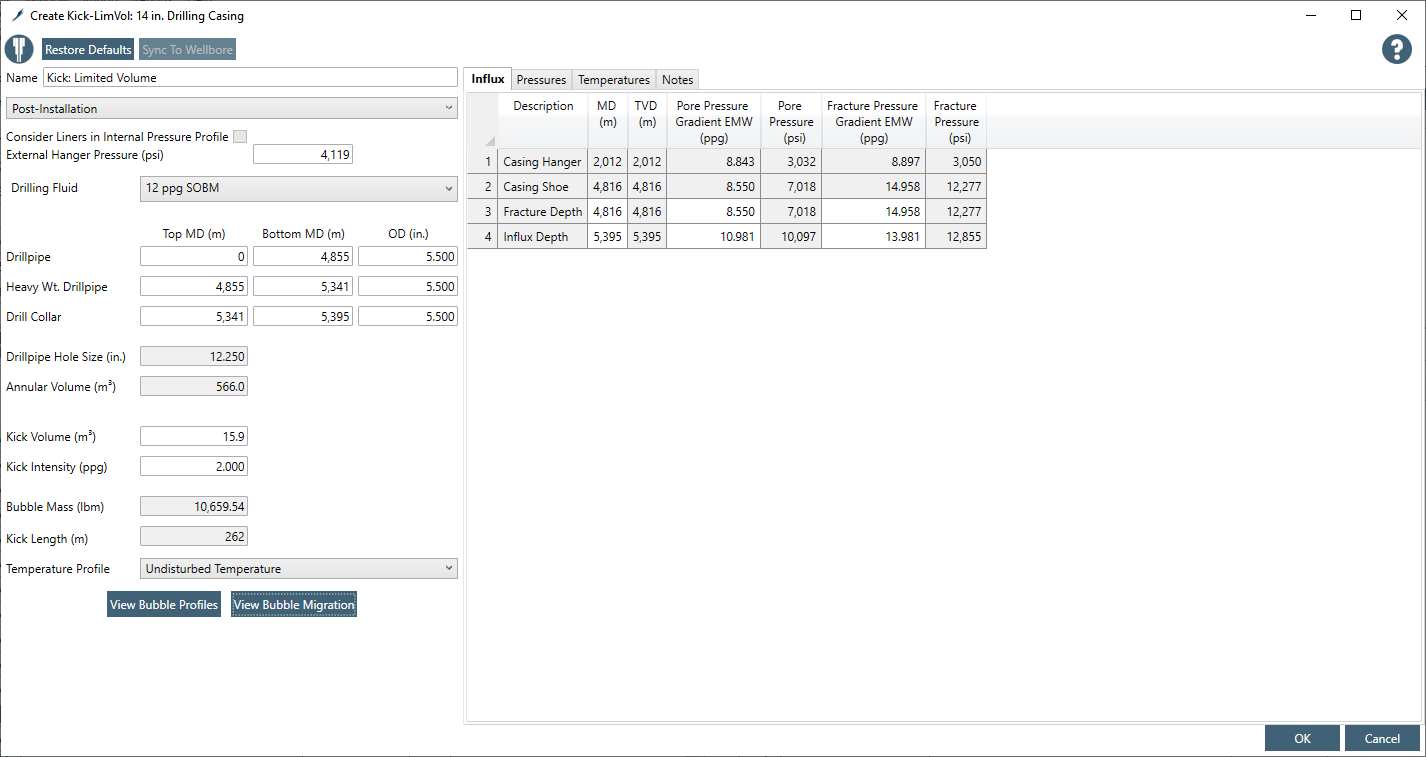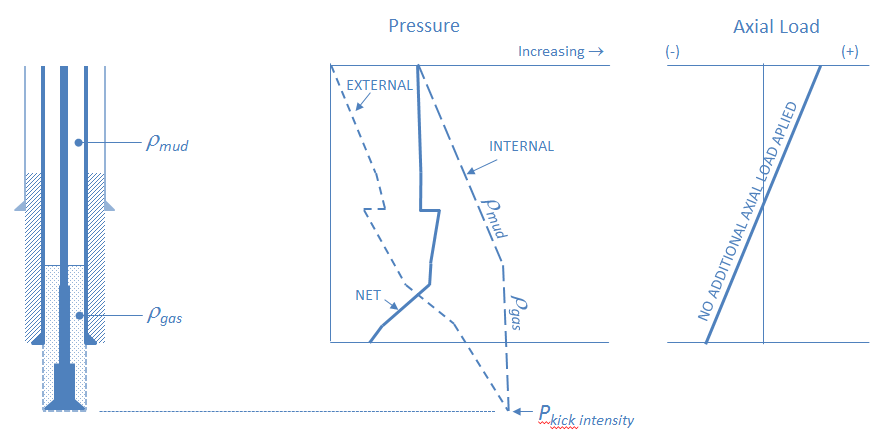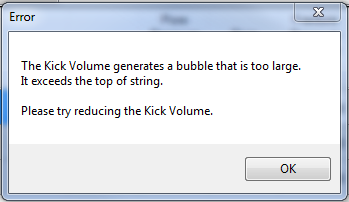¶ Kick: Limited Volume
The Kick: Limited Volume load case is defined as a scenario where the internal pressure is governed by an influx of wellbore fluid into the wellbore. The influx is assumed to be a discrete bubble of gas of a given volume. In this load case, the height of the gas influx depends on the geometry of the drill string in the wellbore at the time the influx enters the wellbore. The influx depth is assumed to be at the bottom of the drill string.
This load case is usually defined as a Post-Installation Load Case.
¶ Inputs
This load case utilizes the Undisturbed Temperature Profile.
The inputs include:
The Name is nothing more than the load's name, which can be edited by the well designer.
The Installation Type defines at what stage this load case takes place, with reference to when the pipe is installed and cemented.
The Consider Liners in Internal Pressure Profile check box provides the user with an option to include or exclude any liners that may be protecting the string. The liners will only be in place after the next section is drilled. Often two Limited Volume Kick load cases will need to be created - once for drilling the next section, and an additional one with Consider Liners in Internal Pressure Profile selected to represent drilling the subsequent section.
The External Pressure at Hanger is the hydrostatic pressure of the annulus fluid at the wellhead. The default value is the pressure resulting from the mud density in which the string was run. While this field can be edited, it will rarely need to be. Considerations for APB and any applied surface pressure can be added to the external hydrostatic pressure at the hanger.
The Drilling Fluid is the density of the mud in the wellbore at the time the influx enters the wellbore. The assumption is that the mud density is constant over the entire length of the wellbore. The default for this value is the fluid density specified in the Casing Program table.
The Drillpipe is the measured depth of the top of the drill string. The default value is zero, assuming that the drill string extends to the drill floor. It is also the drillpipe length and drillpipe OD which is required to define the drillpipe by wellbore annular capacity. Changing the length or OD will highlight those cells in yellow, indicating that their values have been changed from the defaults.
The Heavy Wt. Drillpipe Length and Heavy Wt. Drillpipe OD are needed to define the heavy weight drillpipe by wellbore annular capacity. Changing the length or OD will highlight those cells in yellow, indicating that they have been edited
The Drill Collar Length and Drill Collar OD are needed to define the drill collar by wellbore annular capacity. Changing the length or OD will highlight those cells in yellow, indicating that their values have been changed from the defaults.
Changing the length of any of the drill string components may lead to a situation where the drill string is a different length than the wellbore. This is allowed, but StrinGnosis® will highlight the Influx Depth line in the Influx Table to alert the well designer to this fact.
The Kick Volume is specified by the well designer and represents one of the two key parameters for this load case. The default value is 100 bbls.
The Kick Intensity is also specified by the well designer and represents the second key parameter for this load case. The default value is 2.00 ppg EMW.
Fracture Depth is at the previous shoe by default for the string in question and can be edited to consider any other depth.
Bubble Profile uses wellbore geometric parameters to calculate the position and length of the bubble at a given depth. Users can zoom in and out to see a visual representation of the bubble.

External Pressure Options include:
- Original Mud Weight
- Base Fluid Density
- Sea Water
- Fresh Water
- Cement Mix Fluid Density
- Cement Slurry Density
- Pore Pressure Gradient
- Fracture Pressure Gradient
- Custom
The Original Mud Weight, Base Fluid Density, Sea Water Gradient, Fresh Water Gradient, Cement Mix Fluid Density and Cement Slurry Density, all have default values assigned to them. Values shown for the Original Mud Weight and Cement Slurry Density, which are specific to the string under consideration, were input by the well designer in the Casing Program Tab. The other default values are assigned by StrinGnosis® and cannot be edited. All are constants, except for Base Fluid Density which is either 8.33ppg or 7.00ppg EMW, depending on whether water or oil based mud is specified.
Any of the available fluid choices may be assigned to any region of the wellbore annulus. StrinGnosis® will select the annulus fluids for the default condition based on a set of rules defined in the External Pressure Assumptions Section. The StrinGnosis® default for all Collapse load cases is the hydrostatic pressure of the mud that the casing was run in. These rules have been carefully considered to provide a reasonably conservative estimate of the annular conditions for the load under consideration. A thorough understanding of these assumptions is advised before manually altering the default fluid selections.
¶ Load Case Example

There is an action button labeled Bubble Migration on the input window. Pressing Bubble Migration opens the Bubble Migration Details window where the bubble profiles are tabulated and plotted. Selecting the Bubble Migration sub-tab will produce a plot the pressure at the top of the bubble as a function of the depth of the top of the bubble.
If the influx produces a wellbore pressure at the casing shoe that exceeds the fracture pressure, StrinGnosis® issues an Error Message and asks the well designer to adjust the Kick Volume.
